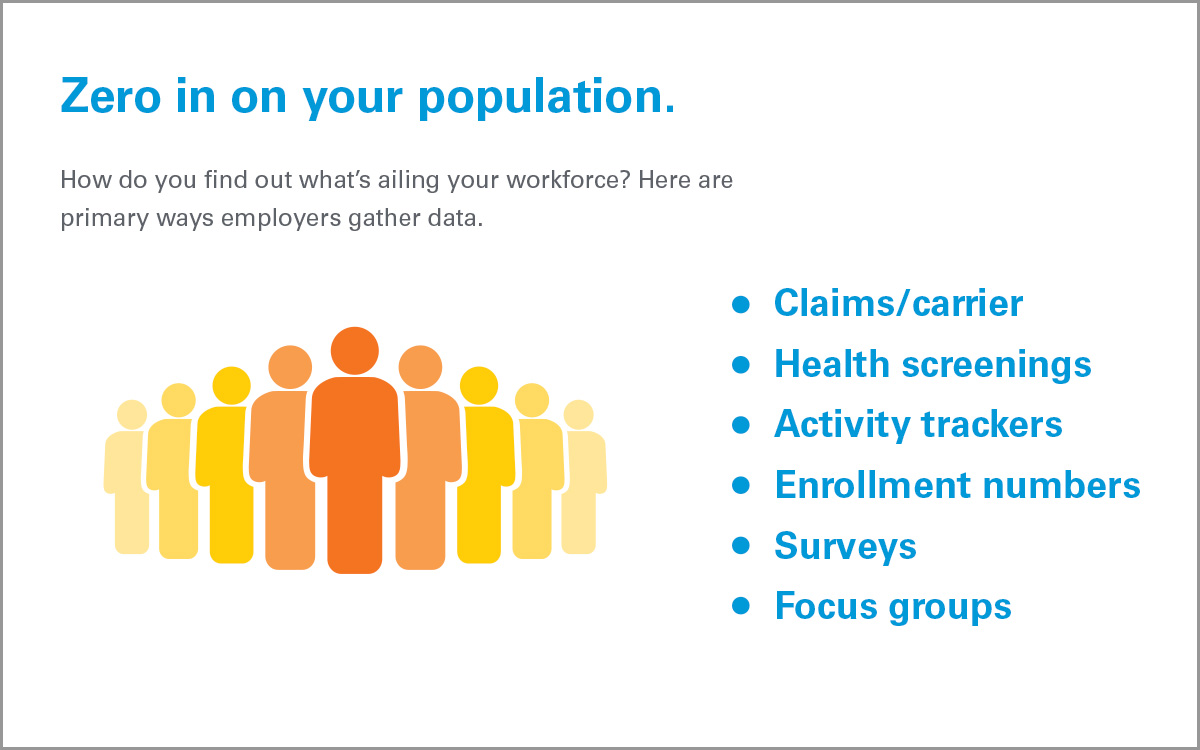
Treat the Person, Cure the Business Need: An Employee-Centered Approach to Healthcare Innovation
November 2019
Vincent Nelson, M.D., Vice President, Medical Affairs, Blue Cross Blue Shield Association
Countless healthcare innovations promise great business results—improved productivity, decreased absenteeism and strong bottom-line benefits. But choosing innovations based on the business need alone can lead to solutions that don’t adequately address underlying employee needs and, as a result, don’t create the desired impact. Employers are better served by flipping the script and treating the person to solve the business need.
Understanding employees' healthcare journey
Effective healthcare innovation starts with personalized insights. Of course, individualizing every solution isn’t possible. But to design an effective solution for a health condition, it’s important to understand what the person with that condition is going through. What’s it like to be in their shoes as they use their health benefits, receive care, manage their condition and overall health all while living a multifaceted professional and personal life?
Your health plan partner’s data is a great resource for getting to know your population. For example, Blue Cross and Blue Shield companies use unmatched data and best-in-class analytics to help employers gain clarity about employees’ needs. From there, look for areas where current programs fall short or have gaps. Employers can also ask employees about their needs through surveys, interviews or focus groups. If your organization offers digital health tools and trackers, that data can add to your picture of health, wellbeing and engagement.

Download complete infographic here
Taking a multidimensional view of employee health
Wellbeing, in life and at work, has many dimensions. While most employers (92 percent) offer mental health initiatives including stress management and resiliency training, employees would like support in other areas, too.1
In one survey, 32 percent of employees listed financial wellbeing as something they’d like help with from their employer.2 And employers are listening, offering financial lunch-and-learns, seminars and one-on-ones with financial advisors. Emerging dimensions include community and even spiritual wellbeing.
Bringing healthcare to employees
Taking a multidimensional view can also mean thinking about how employees might struggle with staying on top of their health given the ever growing demands of work and life. To address this, Independence Blue Cross has developed digital engagement strategies designed to meet members where they are by providing personalized messages to help them better manage their health and maximize their benefits through the convenience of their smart phone, tablet or computer. Once opted in, members will conveniently receive an ongoing series of tailored messages with information, reminders and prompts for action through email or secure text messages. Today, 65 percent of all Independence Blue Cross members have opted in to receive text messages, emails or both. And these strategies are driving measurable results, with members who are digitally engaged being 14 percent less likely to use the ER for non-emergent care, 42 percent more likely to adhere to prescribed medication, and 11 percent more likely to comply with necessary tests and screenings.
Taking time off work for routine doctor appointments can also be a challenge for most employees. When they skip a visit, they could end up requiring more acute care and even more time off work later. To help solve for this, Blue Cross and Blue Shield of Massachusetts installed telehealth kiosks on their workplace premises. Now the company’s 3,800 employees can use the kiosks for private video visits with a licensed provider, who can diagnose and treat routine conditions, including prescribing medication.3
Caring for employees who care for others
As employers approach health and wellbeing from a holistic perspective, many are starting to think about the impact that caregiving for a family member or loved one can have on their employees’ health. According to one study, 54 percent of employers say it’s common for employees to spend up to 20 hours a week on caregiving. And more than 78 percent say those caregivers are more likely than other employees to abandon self-care.4
Blue Cross and Blue Shield companies are collaborating on caregiver programs to provide resources and support for members. Regence BlueCross BlueShield, for example, focuses on connecting caregivers to palliative care resources and the community through its Cambia And Regence Employees Palliative Care Employee Resource Group (CARE PC ERG). The first of its kind in the U.S., the group gathers every month to support each other and share feedback to the company on ways to support employees in this situation. In addition, Regence health plans offer a comprehensive palliative care benefit for members along with counseling and resources for family caregivers, regardless of whether or not they are members.
Florida Blue also helps employees who are caregivers with a dedicated website that provides resources to help them care for a loved one and care for themselves.
Making person-centered healthcare work for your organization
- Data matters. So does compassion. Put your heart in your healthcare. Just knowing you’re concerned about employees’ wellbeing can give them a needed boost.
- Be realistic. Give solutions time to create real ROI. In addition to thinking about bottom-line return, look for improvements around engagement and productivity.
- Vet your partners. Ask your health plan partner or vendor for proven results of any proposed innovations and, first and foremost, be sure those solutions align with your workforce’s needs.
© 2019 Blue Cross Blue Shield Association. All Rights Reserved. The Blue Cross Blue Shield Association is an association of independent, locally operated Blue Cross and Blue Shield companies.
1 National Business Group on Health and Fidelity, “Making Wellbeing Work,” 2018.
2 National Business Group on Health/Optum, “Well-being and the Employee Experience Study,” 2018.
3 Lin Grensing-Pophal, “The Pros, Cons and Possibilities of Onsite Health Care,” SHRM, July 18, 2019.
4 Andrew Soergel, “States Focus on Rise of Elderly Populations,” U.S. News & World Report, Sept. 30, 2019. https://www.usnews.com/news/best-states/articles/2019-09-30/states-focus-on-rise-of-elderly-populations.

 Vincent Nelson, M.D., is vice president of Medical Affairs in the Office of Clinical Affairs (OCA) for the Blue Cross Blue Shield Association (BCBSA), a national federation of 36 independent, community-based and locally operated Blue Cross and Blue Shield (BCBS) companies. Today, one-in-three Americans are covered by the BCBS system.
Vincent Nelson, M.D., is vice president of Medical Affairs in the Office of Clinical Affairs (OCA) for the Blue Cross Blue Shield Association (BCBSA), a national federation of 36 independent, community-based and locally operated Blue Cross and Blue Shield (BCBS) companies. Today, one-in-three Americans are covered by the BCBS system.
